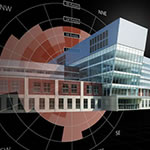gb&d: Can you trace the genesis of the rapid energy modeling method and its benefits to building owners?
Aniruddha Deodhar: The energy-modeling burden was something that’s been the domain of a handful of experts—the work was costly, time consuming, and so unscalable. ICF International estimated that even if 1,000 dedicated energy auditors worked 365 days a year it would take them over 13 years to audit the entire United States commercial building stock.
Emma Stewart: In 2009, there was a significant downturn in new construction. Energy modeling not only was limited to that handful of qualified individuals, but it was exclusive to new construction—the industry was missing 98.5 percent of the building stock every year.
Deodhar: To avoid costs people did back-of-the-napkin calculations, which is like stepping on a scale to determine your overall health. There had to be a middle ground to give useful insights, like an audit, without going through the rigmarole.
gb&d: How does the process work?
Deodhar: There are three simple steps: capture, model, and analyze. The first and biggest challenge is to understand how to quickly capture the geometry of the building, and we do that using what we call “reality capture.” That can be done in a number of ways like laser scanning, which is getting cheaper, and other reality capture tools like photographs, satellite images, aerial images—people are now putting cameras on their drones and flying them around to get a model done. Even the other week, we tested a camera on a Roomba to get building geometry. Once you’re able to capture the outside world, we have software that can mold analog information into a three-dimensional digital form, and we can create a model, leveraging the strength Autodesk has built over the past 10 years in 3-D modeling.
gb&d: How does it save building owners money?
Deodhar: The biggest [saving] is really time. Most of the fixed costs are going to be so miniscule with a software-based approach—we have numerous technologies available for free, but even the overall price of paid software is a fraction of what the labor could have been. Once you have the software you can do as many buildings as you want, and you just need to pay an engineer to do the capture.
gb&d: Who specifically is this software created for? Are there certain types of owners best-suited for this?
Stewart: From a business standpoint, we’re most interested in owners who have large portfolios and, by extension, large ecosystems and are stuck behind a lot of work. From a technology standpoint, the reality capture and the energy analysis components described are best suited for an administrative type of building because that’s the type of building these software programs were built using. But anything where you can get a good sense of the geometry of the building works well, especially in stand-alone buildings.
gb&d: Is there concern that the streamlined process potentially misses any crucial information?
Deodhar: It depends on the goal. Rapid energy modeling is like those body scanners at the airport—they [detect] the gun, but hopefully they don’t capture anything more than they need. If that’s all the user wants, then that scanner is perfect, and rapid energy modeling will show enough of the building to make intelligent decisions and create a strategy for upcoming energy conversion measures without getting into the weeds.
gb&d: So what’s the main takeaway from the software?
Stewart: Because we serve the manufacturing industry, many of the manufacturers who are producing the materials that go into buildings are doing so with gaps in knowledge of what the architects and engineers want to know with respect to their environmental performance. We can connect those two groups and address the information asymmetry to create a marketplace of environmental data, [which ultimately translates] into operations by ensuring that facility managers are equipped with the greatest intelligence they can possibly have from the architect, the engineer, and the manufacturer.

